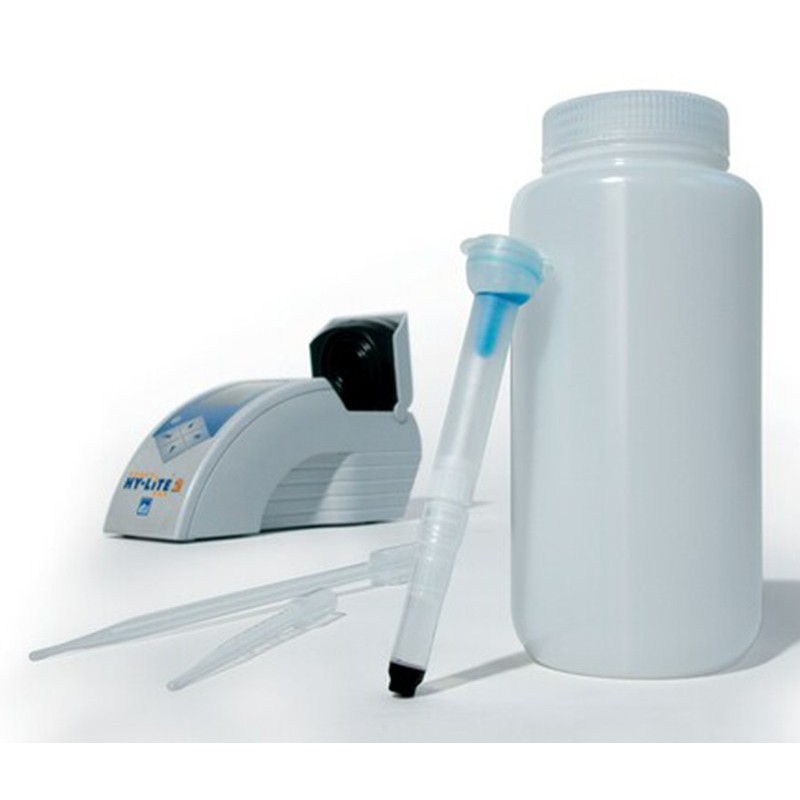




Box with 20 HY-LiTE® Pens. HY-LiTE® Pen is a test cuvette with ready-to-use reagents designed for use in the HY-LiTE® Jet A1 fuel test hardware. Test reagents stored at + 2 to + 8 ° C are stable until the date stated on the package. The shelf life also includes transport or storage for up to 3 weeks at room temperature.
(Excerpts, note the complete instructions after purchase + BEFORE use) HY-LiTE® Pen consists of the following parts:
• Protective cap for the sample tube with integrated capture solution (patent pending).
• A white sample pen (protected by the protective cap) for accurate sampling of the liquid to be tested. The pen is coated with an extractant that releases ATP from cellular material. The sample pen is also used to transfer the sample into the cuvette + in a later step to open the reagent chamber.
• Cuvette with test buffer for diluting, buffering and neutralizing the sample.
• Reagent chamber sealed with aluminum foil with a freeze-dried + stabilized luciferin / luciferase mixture (US patents 5583024, 5674713, 5700673).
Method
Microorganisms and water-soluble metabolites (including ATP) are bound from the fuel phase and concentrated in the blue phase of the capture solution. Adenosine triphosphate (ATP) is specifically detected by reaction with a luciferin / luciferase mixture in a buffered solution. The light emitted is measured in the HY-LiTE® Jet A1 fuel hardware and the measurement result is displayed.
Execution
Preparation of the measurement sample (according to the illustrated instructions):
1) Take up one liter of a fuel sample in a suitable plastic container (e.g. Nalgen Art. No. 2104-0032 or 332189-0032).
2) Remove the small pipette from the bag. Do not touch the pipette tip.
3) With the suction ball pressed in, dip the pipette tip into the capture solution in the HY-LiTE sample tube. Release the suction ball to draw all of the capture solution into the pipette. Add the capture solution to the fuel sample.
4) Close the lid tightly and shake vigorously for 10 seconds. Discard the small pipette.
5) Let the fuel sample treated with the capture solution stand for at least 5 minutes.
6) Remove the large pipette from the bag. Do not touch the pipette tip. With the suction ball pressed in, dip the pipette tip into the blue capture solution at the bottom of the fuel sample vessel.
7) Release the suction bulb to draw all of the capture solution into the pipette.
8) Transfer the blue capture solution into the HY-LiTE sample tube. The liquid level must at least cover the floor. Be careful not to spill any fuel phase into the sample tube. Discard the large pipette.
9) Carefully pull the pen out of the protective cap for the sample tube.
10) Immerse the white sample pen completely in the capture solution for approximately one second.
11) Carefully pull the sample pen out of the sample tube.
12) Then place the sample pen on the upper part of the protective cap (or another solid surface) and push it vertically (to prevent the pen from breaking off) completely into the cuvette chamber while applying even pressure. At this point the test can be interrupted for up to 48 hours.
13) Turn the upper part of the pen clockwise until it stops against the lower part. The aluminum foil of the reagent chamber is slit open with the sharp end of the test pin and the chamber is opened.
14) Shake the pen vigorously at least ten times. This mixes the sample with the reagent (foam is created and the color changes to yellow-green).
15) Immediately insert the pen into the measuring chamber of the HY-LiTE® luminometer and close the lid to start the measurement.
Influence of foreign substances
Chemical additives and impurities such as B. FSII and anti-rust agents can affect the effectiveness of the capture solution and the HY-LiTE reaction
and lead to lower reading results than expected. Biocides for treating contaminated fuel can influence the chemical reaction depending on their concentration and the type of biocide in the fuel.
The effect of Kathon FP1.5 at 100 ppm w / w and Biobor JF at 270 ppm w / w in fuel has been investigated, with no significant impairment of the HY-LiTE test being found.
Hints
• Because ATP is a widespread substance, the following parts must not be touched with the fingers or contaminated in any other way: pipette tips, lid or edge of the protective cap with the capture solution and the white sample pen.
• The sealed pipette bags should be opened with a suitable clean tool (scissors or knife). To reduce the risk of contamination of the pipette, push the plunger end of a pipette out of the open pouch and only then grasp the pipette to pull it out.
• The pen must not be written on or affixed with labels in the area of the measurement window for the light reaction, ie where the plastic is clear and transparent.
• To avoid damaging the luminometer, push the white sample pen all the way into the pen and screw both parts of the pen together until they stop.
• Do not hold or twist the black cap of the reagent chamber. Otherwise the pen could leak.
• Gloves may be worn when handling the fuel samples and treating them with the capture solution. However, gloves must not be worn when handling the HY-LiTE sample pen (steps 8 to 13).
• The use of special sample containers is provided for carrying out the test (Nalgen Art. No. 2104-0032 or 332189-0032). Other sample vessels may also work, but the manufacturer has not verified test performance with other vessels. The use of glass vessels is not recommended.
• HY-LiTE® Pens can be disposed of with normal household waste.
• We reserve the right to make technical changes to the test or the kit in line with technical progress.
Status 03-2020
You might also like